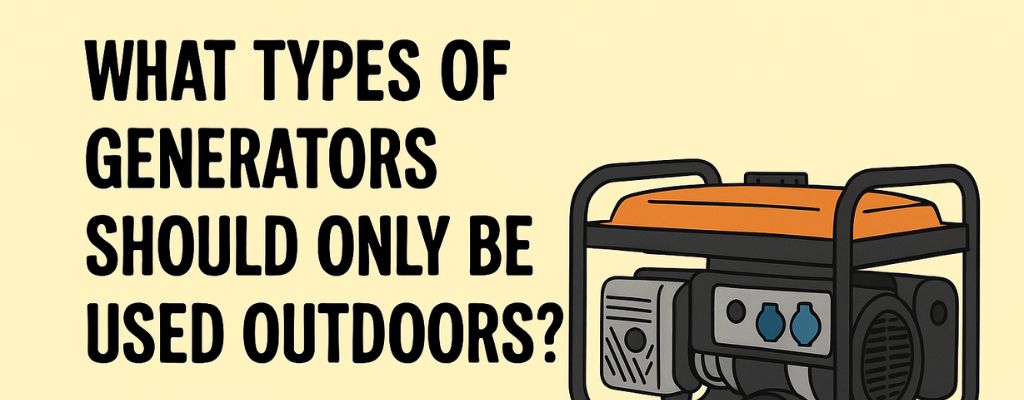
What Types of Generators Should Only Be Used Outdoors?
Ever tried running a generator in your lounge room? Bad idea—unless you enjoy surprise naps with permanent consequences. Generators like petrol, diesel, and other fuel-powered types should only be used outdoors. Why? Because they pump out carbon monoxide—a silent killer. If you want to stay powered and breathing, keep reading.

The Universal Rule: Why Carbon Monoxide Demands Outdoor-Only Generator Operation
Understanding Carbon Monoxide: The Silent Killer from Your Generator
Carbon monoxide is like a ninja. You cannot see it. You cannot smell it. You definitely will not hear it coming.
Yet this invisible gas can knock you out in minutes. One bad call with your generator indoors, and that “convenient backup” turns into a deadly mistake.
How Fuel-Burning Generators Produce Dangerous Carbon Monoxide Fumes
Generators work by burning fuel—petrol, diesel, or gas. And where there’s fire, there’s exhaust.
That exhaust is loaded with carbon monoxide. If you’re running your generator in a garage, shed, or even near an open window, the fumes can drift straight in. It does not take much to turn a simple outage into a medical emergency.
The Invisible Threat: Why You Can't See, Smell, or Taste Carbon Monoxide from Your Generator
This is what makes it so dangerous—it gives you no warning. No smoke. No odour. No colour.
You start feeling dizzy, maybe a bit off. Before you know it, you’re unconscious. That’s why carbon monoxide alarms exist—and why your generator should always be outside.
Identifying the Primary Types of Power Generators That Produce Harmful Emissions
Conventional Combustion Generators: The Main Source of Dangerous Fumes
These are the classic petrol or diesel-powered generators you’ll see on job sites and in backyards.
They’re reliable, powerful, and perfect for emergencies. But they’re also emission machines. If they’re not running in open air, you’re putting yourself—and your family—at serious risk.
The Dangers of Indoor Use: Symptoms and Consequences from Your Generator
Carbon monoxide poisoning feels a lot like the flu at first. You might get a headache or feel a bit woozy.
But the danger escalates fast. Nausea. Confusion. Blacking out. It only takes one bad placement of your generator to end up in hospital—or worse.

Different Types of Generators for Home Use: Which Ones Belong Outside?
What are the 2 Types of Generator Most Common for Homes? (Portable vs. Standby)
Portable Generators: The Go-To for Temporary Outdoor Power Needs
These are your camping heroes and blackout best mates. Easy to carry, store, and fire up when the lights go out.
But here’s the thing—they're still fuel-burners. Which means never use them inside. Not in the garage, not in the laundry, not even under a carport.
Standby Generators: Permanent Outdoor Installations for Whole-Home Backup
These big units are installed outside and automatically kick in when the power drops.
Because they run on fuel—natural gas, LPG, or diesel—they’re built for outdoor use only. Professional installation, airflow, and regular servicing are non-negotiable.
What are the 3 Types of Generators Often Discussed for Residential Applications? (Portable, Inverter, Standby)
Inverter Generator: Cleaner Power, But Still an Outdoor Generator Due to Emissions
Inverter generators are a smarter breed. They’re quiet, fuel-efficient, and safe for sensitive electronics.
But they still burn fuel. And burning fuel means emissions. So even your fancy inverter model needs a nice spot outside.
Why Even Quiet Inverter Generators Must Be Used Outdoors
Some people think, “It’s so quiet, it can’t be dangerous.” Wrong.
Silence does not mean safety. Carbon monoxide still flows from the exhaust. Whether it’s whisper-quiet or roaring loud, if it’s burning fuel—it belongs outside.
Best Generator for Power Outage at Home: Making the Right Outdoor Choice
Balancing Power Needs with Safety for Your Home Generator
Power cuts happen. But that does not mean you should panic-buy the biggest generator on the shelf.
Start by listing what you actually need—fridge, modem, heater? Add up the wattage. Then pick a model that meets your needs and can be placed safely outdoors.
Assessing Features and Benefits of Different Types of Generators for Home Backup
Each type has its perks:
-
Portable: Affordable, flexible, but manual and needs refuelling.
-
Inverter: Efficient and quiet but best for smaller loads.
-
Standby: Fully automatic and powerful, but pricey.
Just remember—no matter the type, all fuel-powered models should be placed outdoors.

Safe Outdoor Placement and Operation of Your Generator
Essential Clearances: Where to Position Your Outdoor Generator
Maintaining Safe Distances from Doors, Windows, and Vents for Your Generator
Six metres. That’s the magic number. Your generator should be at least that far from your home’s openings.
Windows, doors, vents—fumes can sneak through all of them. Keep your generator away, or risk turning your lounge room into a gas trap.
Ensuring Adequate Airflow Around Your Generator for Proper Ventilation
Generators need space to breathe. Do not wedge them in between walls or hide them in a tiny corner.
Good airflow keeps them cool and keeps exhaust gases moving away from you. Think open space, not a boxed-in setup.
Noise Considerations and Local Regulations for Your Outdoor Generator
Understanding Decibel Levels and Their Impact on Neighbours from Your Generator
Standard generators can be noisy—somewhere between a hairdryer and a lawnmower. That might not fly if you’re in a quiet suburban street.
Inverter models are much quieter and often sit below the 60 dB mark. If you value your neighbourly reputation, it’s worth the upgrade.
Complying with Local Ordinances for Generator Operation in Residential Areas
Different councils have different rules. Some limit how long or when you can run your generator.
Check your local laws. No one wants a knock at the door mid-storm from council inspectors—or cranky neighbours.
General Generator Safety Practices for Any Outdoor Power Unit
Proper Fuel Handling and Storage for Your Outdoor Generator
Store fuel in approved containers, away from the generator and anything flammable.
Never refill while the engine’s hot. It only takes one spark to start a fire. And always lock up your fuel away from kids and pets.
Installing Carbon Monoxide Alarms Indoors, Even with Outdoor Generator Use
Carbon monoxide can drift. Even if your generator is outside, fumes can still make their way indoors.
Install CO alarms inside your home—especially near bedrooms. They’re cheap, easy, and can quite literally save your life.
Conclusion: Prioritising Safety by Keeping Fuel-Burning Generators Outdoors is Paramount
Generators are lifesavers—when used the right way. But no matter how quiet, compact, or clever they seem, if it burns fuel, it belongs outside.
Stick to the rules. Keep your distance. Follow the safety basics. Because powering your home should never come at the cost of your health.


